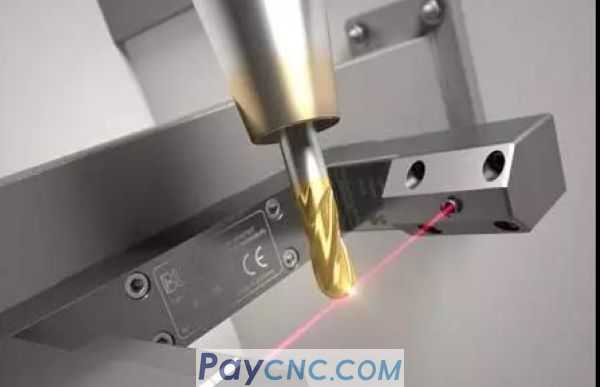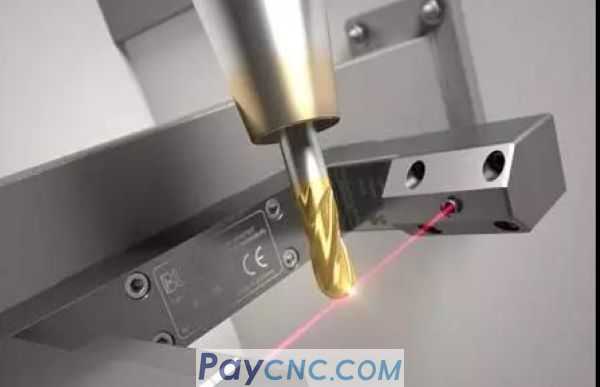Introduction: CNC lathe tool setting is an important skill in processing. The accuracy of tool setting determines the accuracy of parts processing. Tool setting efficiency directly affects the processing efficiency of parts. Tool setting is very important for machine tool processing operations.

After turning on the CNC lathe, the zero return (reference point) operation must be carried out. Its purpose is to establish a unified benchmark for position measurement, control and display of the CNC lathe, that is, the tool returns to the machine origin. The machine origin is usually at the maximum positive stroke of the tool , Its position is determined by the machine tool position sensor.
After the machine tool returns to zero, the distance between the position of the tool (tool tip) and the origin of the machine tool is fixed. Therefore, to facilitate tool setting and processing, the position of the tool tip after the machine tool returns to zero can be regarded as the origin of the machine tool. Tool setting is the operation process of establishing the workpiece coordinate system in the machine tool coordinate system of the CNC machine tool and making the origin of the workpiece coordinate system coincide with the programming origin.
Measure the distance between the tool tip programming point in the machine tool coordinate system and the machining origin in the X and Z directions by trial cut or non-contact method, and set the value to the machine tool parameters. Through the program call, the workpiece coordinate system is established. The base point of the program The absolute coordinate value is the origin of the established workpiece coordinate system as the origin, and the contour of the part is processed.
1. The principle of tool setting
The purpose of tool setting is to establish the workpiece coordinate system. Intuitively speaking, tool setting is to establish the position of the workpiece in the machine tool table. In fact, it is to find the coordinates of the tool setting point in the machine tool coordinate system.
For CNC lathes, the tool setting point must be selected before processing. The tool setting point refers to the starting point of the tool's movement relative to the workpiece when the workpiece is processed with a CNC machine tool. The tool setting point can be set on the workpiece (such as the design reference or positioning reference on the workpiece), or on the fixture or machine tool. If it is set at a certain point on the fixture or machine tool, the point must be aligned with the positioning reference of the workpiece Maintain the dimensional relationship of a certain accuracy.
When calibrating the tool, the position of the finger point should coincide with the point of tool setting. The so-called tool point refers to the positioning reference point of the tool. For turning tools, the tool point is the tool tip. The purpose of tool setting is to determine the absolute coordinate value of the tool setting point (or workpiece origin) in the machine tool coordinate system, and to measure the tool position deviation value of the tool. The accuracy of aligning the tool point directly affects the machining accuracy.
In the actual processing of workpieces, the use of one tool generally cannot meet the processing requirements of the workpiece, and usually multiple tools are used for processing. When processing with multiple turning tools, the geometric position of the tool tip point will change when the tool change position is unchanged, which requires different tools to start processing at different starting positions. Ensure that the program runs normally.
In order to solve this problem, the machine tool CNC system is equipped with the tool geometric position compensation function. With the tool geometric position compensation function, as long as the position deviation of each tool relative to a pre-selected reference tool is measured in advance, it is input to the CNC system In the tool parameter correction column of the specified group number, use the T command in the machining program to automatically compensate the tool position deviation in the tool path. The measurement of tool position deviation also needs to be realized by tool setting operation.

Second, the tool setting method
In CNC machining, the basic methods of tool setting include trial cutting method, tool setting tool setting and automatic tool setting. This article takes a CNC milling machine as an example to introduce several commonly used tool setting methods.
1. Trial cutting method
This method is simple and convenient, but it will leave cutting marks on the surface of the workpiece and the tool setting accuracy is low. Take the tool setting point (here coincident with the origin of the workpiece coordinate system) at the center of the workpiece surface as an example to adopt the bilateral tool setting method.
(1) x, y to the knife.
①Install the workpiece on the worktable through the fixture. When clamping, the four sides of the workpiece should be set aside for tool setting.
②Start the spindle to rotate at medium speed, move the table and the spindle quickly, and move the tool to a position close to the left side of the workpiece with a certain safety distance, and then reduce the speed to move to the left side of the workpiece.
③When approaching the workpiece, use the fine adjustment operation (usually 0.01mm) to approach, let the tool slowly approach the left side of the workpiece, so that the tool just touches the surface of the left side of the workpiece (observe, listen to the cutting sound, see the cutting marks, see the chips, as long as When a situation occurs, it means that the tool touches the workpiece), and then retracts by 0.01mm. Write down the coordinate value displayed in the machine coordinate system at this time, such as -240.500.
④Retract the tool in the positive z direction, above the surface of the workpiece, approach the right side of the workpiece in the same way, and record the coordinate value displayed in the machine coordinate system at this time, such as -340.500.
⑤According to this, the coordinate value of the origin of the workpiece coordinate system in the machine tool coordinate system is {-240.500+(-340.500)}/2=-290.500.
⑥ Similarly, the coordinate value of the origin of the workpiece coordinate system in the machine tool coordinate system can be measured.
(2) Z-direction tool setting.
① Move the tool quickly over the workpiece.
②Start the spindle to rotate at medium speed, move the table and spindle quickly, and move the tool to a position close to the upper surface of the workpiece with a certain safety distance, and then reduce the speed to move the end face of the tool to the upper surface of the workpiece.
③When approaching the workpiece, use a fine adjustment operation (generally 0.01mm) to approach, so that the end face of the tool slowly approaches the surface of the workpiece (note that the cutter, especially the end mill, is best to cut the edge of the workpiece, the end face of the tool contacts the surface area of the workpiece Less than half circle, try not to make the center hole of the end mill under the workpiece surface), so that the end face of the tool just touches the upper surface of the workpiece, then raise the axis again, and record the z value in the machine tool coordinate system at this time, -140.400 , The coordinate value of the workpiece coordinate system origin W in the machine tool coordinate system is -140.400.
(3) Input the measured x, y, z values into the storage address G5* of the machine tool workpiece coordinate system (generally use G54~G59 codes to store the tool setting parameters).
(4) Enter the panel input mode (MDI), enter "G5*", press the start key (in automatic mode), run G5* to make it effective.
(5) Check whether the tool setting is correct.

2, feeler gauge, standard mandrel, block gauge tool setting method
This method is similar to the trial cutting tool setting method, except that the spindle does not rotate during tool setting, and a feeler gauge (or standard mandrel, block gauge) is added between the tool and the workpiece. The gauge cannot be freely twitched. In the case of coordinates, the thickness of the feeler gauge should be subtracted. Because the spindle does not need to rotate and cut, this method will not leave marks on the surface of the workpiece, but the accuracy of the tool setting is not high enough.
3. Adopt tools such as edge finder, eccentric rod and shaft setter for tool setting
The operation steps are similar to the trial cutting tool setting method, except that the tool is replaced with an edge finder or an eccentric rod. This is the most common method. High efficiency, can guarantee the accuracy of tool setting. When using the edge finder, care must be taken so that the steel ball part is in slight contact with the workpiece. At the same time, the workpiece to be processed must be a good conductor, and the positioning reference surface has a good surface roughness. The z-axis setter is generally used for transfer (indirect) tool setting method.
4. Transfer (indirect) tool setting method
More than one knife is often used to process a workpiece. The length of the second knife is different from the length of the first knife. It needs to be re-zeroed, but sometimes the zero point is processed and the zero point cannot be retrieved directly, or not It is allowed to destroy the processed surface, and some tools or occasions are not good for direct tool alignment. In this case, indirect change can be used.
(1) To the first knife
① For the first knife, still use the trial cutting method and feeler gauge method. Write down the machine coordinate z1 of the workpiece origin at this time. After the first tool is processed, the spindle is stopped.
②Place the tool setting device on the flat surface of the machine table (such as the large surface of the vise).
③ In the handwheel mode, use the hand to move the worktable to a suitable position, move the spindle down, press the top of the knife set with the bottom end of the knife, the dial pointer rotates, preferably within a circle, write down the axis at this time Set the indication of the device and clear the relative coordinate axis.
④ Make sure to raise the spindle and remove the first knife.
(2) To the second knife.
① Install the second knife.
② In the handwheel mode, move the spindle downward, press the top of the tool setter with the bottom end of the knife, the dial pointer rotates, and the pointer points to the same position A as the first knife.
③Record the value z0 (with positive and negative signs) corresponding to the relative coordinate of the axis at this time.
④ Raise the spindle and remove the tool setting device.
⑤ Add z0 (with positive and negative signs) to the z1 coordinate data in G5* of the original first tool to get a new coordinate.
⑥ This new coordinate is the actual machine coordinate of the origin of the workpiece corresponding to the second tool, and input it into the G5* working coordinates of the second tool. In this way, the zero point of the second tool is set . The rest of the knife is the same as the second knife.
Note: If several tools use the same G5*, the steps ⑤ and ⑥ are changed to store z0 in the length parameter of the second tool, and the tool length correction G43H02 can be called when processing with the second tool.
5. Top-level tool setting method
(1) x, y to the knife.
① Install the workpiece on the machine table through the jig and replace it with the center.
②Move the table and spindle quickly, move the center to the top of the near workpiece, find the center point of the workpiece drawing line, reduce the speed and move the center to close to it.
③ Change to fine-tuning operation, make the center point approach the center point of the workpiece drawing line slowly, until the center point point is aligned with the center point of the workpiece drawing line, and record the x, y coordinate values in the machine tool coordinate system at this time.
(2) Remove the center, install the milling cutter, and use other tool setting methods such as trial cutting method and feeler gauge method to get the z-axis coordinate value.
6. Dial gauge method (or dial gauge)
Dial gauge (or dial gauge) tool setting method (generally used for tool setting of round workpieces)
(1) x, y to the knife.
Install the dial's mounting rod on the tool holder, or suck the dial's magnetic seat on the spindle sleeve, move the worktable to move the spindle centerline (ie, tool center) to the center of the workpiece, and adjust the magnetic seat The length and angle of the telescopic rod make the contact of the dial indicator touch the circumferential surface of the workpiece (the pointer rotates about 0.1mm). Turn the spindle slowly by hand to rotate the contact of the dial indicator along the circumferential surface of the workpiece. Observe The movement of the pointer of the dial indicator, slowly move the axis and axis of the worktable. After repeated iterations, the pointer of the dial indicator is basically at the same position when the main shaft is turned (when the head rotates once, the jump of the pointer is Within the allowable tool setting error, such as 0.02mm), the center of the spindle can be regarded as the origin of the axis and the axis.
(2) Remove the dial indicator and install the milling cutter. Use other tool setting methods such as trial cutting method and feeler gauge method to get the z-axis coordinate value.
7. Special tool setting method
The traditional tool setting method has poor safety (such as feeler tool setting, hard touch and the tip of the tool is easy to break). It takes a lot of machine time (such as trial cutting requires repeated cutting several times), and the artificial random error is large. It has been adapted The rhythm of CNC machining cannot be achieved, and it is not conducive to exert the functions of CNC machine tools. Using a special tool setting tool for tool setting has the advantages of high tool setting accuracy, high efficiency, and good safety. It simplifies the cumbersome tool setting work guaranteed by experience and ensures the high-efficiency and high-precision characteristics of CNC machine tools. A special tool that is indispensable to solve tool-to-tool on CNC processing machine.
|
 |
| Products Catalogue | Home | About Us | Retrofit | Download | News | Tech Support | Contact Us | |
|
|
|
